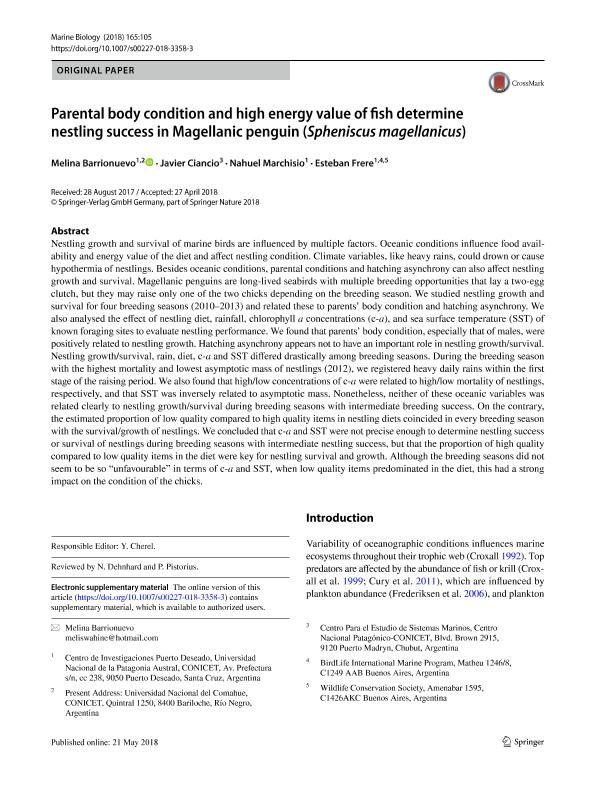Artículo
Parental body condition and high energy value of fish determine nestling success in Magellanic penguin (Spheniscus magellanicus)
Fecha de publicación:
06/2018
Editorial:
Springer
Revista:
Marine Biology
ISSN:
0025-3162
Idioma:
Inglés
Tipo de recurso:
Artículo publicado
Clasificación temática:
Resumen
Nestling growth and survival of marine birds are influenced by multiple factors. Oceanic conditions influence food availability and energy value of the diet and affect nestling condition. Climate variables, like heavy rains, could drown or cause hypothermia of nestlings. Besides oceanic conditions, parental conditions and hatching asynchrony can also affect nestling growth and survival. Magellanic penguins are long-lived seabirds with multiple breeding opportunities that lay a two-egg clutch, but they may raise only one of the two chicks depending on the breeding season. We studied nestling growth and survival for four breeding seasons (2010–2013) and related these to parents’ body condition and hatching asynchrony. We also analysed the effect of nestling diet, rainfall, chlorophyll a concentrations (c-a), and sea surface temperature (SST) of known foraging sites to evaluate nestling performance. We found that parents’ body condition, especially that of males, were positively related to nestling growth. Hatching asynchrony appears not to have an important role in nestling growth/survival. Nestling growth/survival, rain, diet, c-a and SST differed drastically among breeding seasons. During the breeding season with the highest mortality and lowest asymptotic mass of nestlings (2012), we registered heavy daily rains within the first stage of the raising period. We also found that high/low concentrations of c-a were related to high/low mortality of nestlings, respectively, and that SST was inversely related to asymptotic mass. Nonetheless, neither of these oceanic variables was related clearly to nestling growth/survival during breeding seasons with intermediate breeding success. On the contrary, the estimated proportion of low quality compared to high quality items in nestling diets coincided in every breeding season with the survival/growth of nestlings. We concluded that c-a and SST were not precise enough to determine nestling success or survival of nestlings during breeding seasons with intermediate nestling success, but that the proportion of high quality compared to low quality items in the diet were key for nestling survival and growth. Although the breeding seasons did not seem to be so “unfavourable” in terms of c-a and SST, when low quality items predominated in the diet, this had a strong impact on the condition of the chicks.
Palabras clave:
isotopos
,
crecimiento de pichones
,
condicion fisica de los padres
Archivos asociados
Licencia
Identificadores
Colecciones
Articulos(CCT - PATAGONIA NORTE)
Articulos de CTRO.CIENTIFICO TECNOL.CONICET - PATAGONIA NORTE
Articulos de CTRO.CIENTIFICO TECNOL.CONICET - PATAGONIA NORTE
Citación
Barrionuevo, Melina; Ciancio Blanc, Javier Ernesto; Marchisio, Nahuel Matías; Frere, Esteban; Parental body condition and high energy value of fish determine nestling success in Magellanic penguin (Spheniscus magellanicus); Springer; Marine Biology; 165; 6; 6-2018
Compartir
Altmétricas




